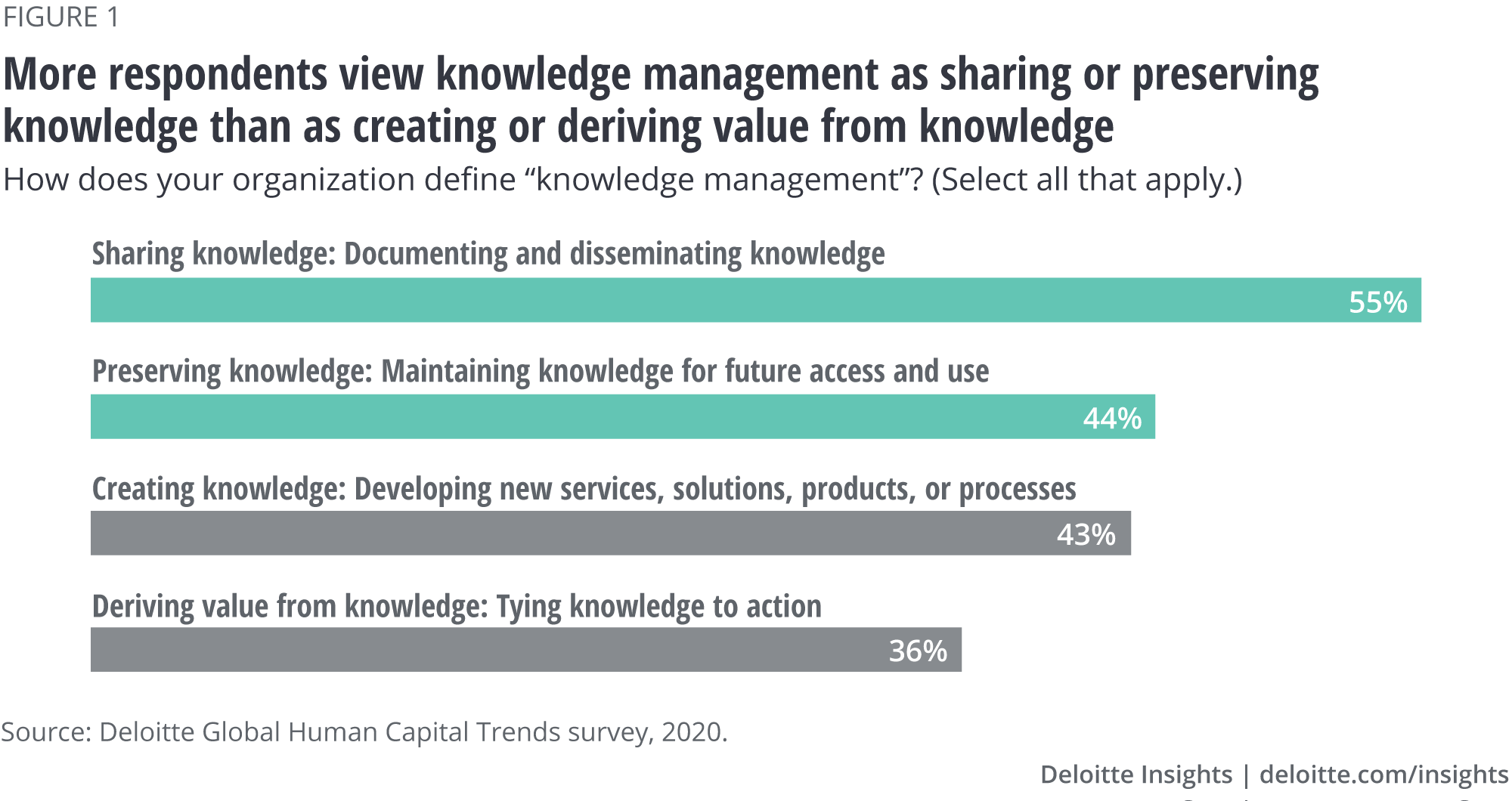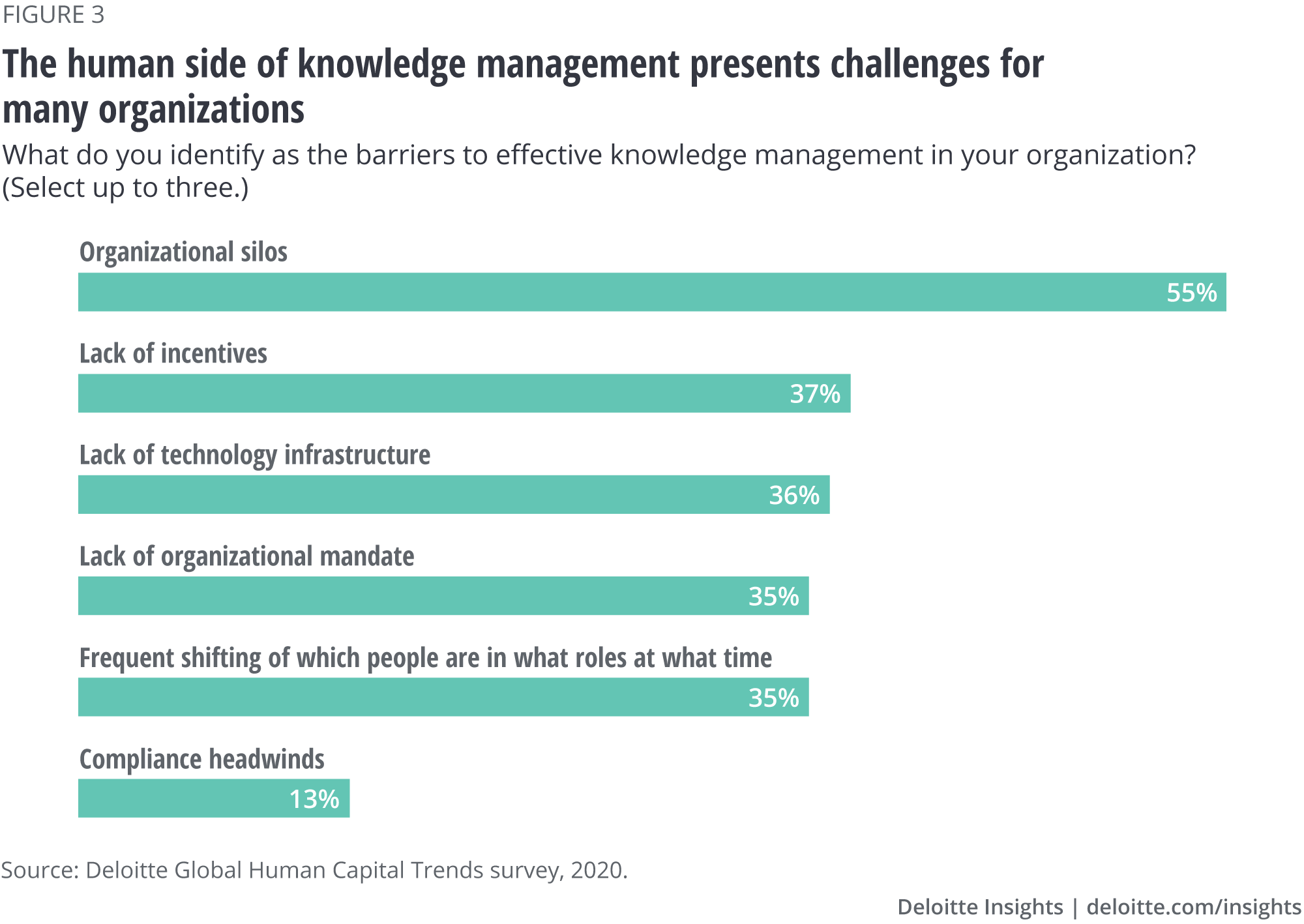
Knowledge management Creating context for a connected world
9 minute read
15 May 2020
For organizations that are struggling with knowledge management, new technology solutions can help. But beyond technology, organizations must also help workers understand that sharing their knowledge makes them more relevant, not less.
2021 Global Human Capital Trends
Sign up to receive a copy of our new approach to Trends launching this winter
Knowledge has been and will continue to be a key competitive differentiator when it comes to driving organizational performance. The power of people and machines working together offers the greatest opportunity for creating knowledge in human history. However, advanced technologies, new ways of working, and shifts in workforce composition are rendering traditional views of knowledge management obsolete. To capitalize on these changes, many organizations need to redefine how they promote knowledge creation to help maximize human potential at work.
The Readiness Gap: Seventy-five percent of surveyed organizations say creating and preserving knowledge across evolving workforces is important or very important for their success over the next 12–18 months, but only 9 percent say they are very ready to address this trend; this represents one of the largest gaps between importance and readiness across this year’s trends.
Learn more
Explore the Human Capital Trends collection
Watch the video
Learn about Deloitte's services
Order a copy of Work Disrupted, Deloitte's new book on the accelerated future of work
Explore 5 lessons from the pandemic for the future of work
Go straight to smart. Get the Deloitte Insights app
Create a custom PDF
Current drivers
Technology is undoubtedly a big part of the growing need for more effective knowledge management. In the digital, hyperconnected era, organizations are collecting and generating a “tsunami of data,”1 but few are able to capitalize on its full potential. According to Statista, more than 293 billion emails were sent and received each day in 2019.2 Yet according to a global survey of 1,300 business and IT executives, an average of 55 percent of enterprise data goes unused.3
Technology has also spawned new ways of working that make the knowledge management need more urgent. With the explosion of workforce conversations on digital collaboration tools, knowledge no longer sits in databases waiting to be accessed but flows dynamically across the digital communications channels that now define working relationships. As a case in point, Microsoft Teams and Slack, two digital communications tools used in many workplaces today, report 13 million and 12 million daily active users, respectively.4
New ways of working have also increased worker mobility. Workers in both traditional and alternative work arrangements are moving across jobs, projects, teams, geographies, and organizations more than ever before, taking critical knowledge with them. In this year’s Global Human Capital Trends survey, 52 percent of our respondents said that workforce movement is driving them to proactively develop their knowledge management strategies. And 35 percent said that the frequent shifting of which people are in what roles at what time is a barrier to effective knowledge management.
And yet, despite an acknowledgment that the ways in which work is happening have shifted, many organizations’ approaches to knowledge management have not kept pace. Our survey shows that almost half of the respondents do not provide members of the alternative workforce access to knowledge-sharing tools and platforms, and only 16 percent see integrating knowledge management across off- and on-balance-sheet workers as a key factor to consider in proactively developing their knowledge management strategies. In a world where the use of the gig economy continues to expand, this could become a significant barrier to creating knowledge in the future.
Our 2020 perspective
Our research this year shows that many organizations remain focused on—and struggle with—the basics of knowledge management. More than half of the respondents to this year’s Global Human Capital Trends survey (55 percent) still define knowledge management as the simple documenting and disseminating of knowledge. Far fewer link knowledge with action to drive value (36 percent), while less than half (43 percent) see creating knowledge as a key to developing new products, services, or solutions (figure 1).

Knowledge management through the years in Global Human Capital Trends
Knowledge management has evolved in leaps and bounds over the last decade with the emergence of new technologies that capture and disseminate information at rapid speeds. Our Global Human Capital Trends reports have reflected that journey, acknowledging the importance of employee knowledge-sharing to business success in 2014, discussing the development of internal knowledge-sharing programs in 2016, and marking the emergence of new learning and knowledge-sharing systems in 2018 that curate both internal content and open-source content for worker use and development. In 2019, our top-ranked trend was “Learning in the flow of life,” in which we discussed the shift from knowledge-sharing and learning as something that happens separately from work to something that is integrated into workflows in small doses, almost invisibly, throughout the workday. This year, we build on that perspective, describing ways that organizations should leverage new technologies that can not only contextualize information, but push it through an organization’s systems to teams in ways that support problem-solving and help workers innovate and uncover new insights.
The overwhelming majority of organizations understand they are falling short. Eighty-two percent of our respondents said their organizations need to do a better job of tying knowledge to action, while 79 percent admitted that they must be more effective at creating knowledge to jump-start innovations and launch new products and services.
For organizations that are struggling, the good news is that technology is offering up solutions that can help. Emerging AI capabilities such as natural language processing and natural language generation can automatically index and combine content across disparate platforms. These same technologies can also tag and organize information, automatically generating contextual metadata without human intervention and eliminating a major barrier to actually using the knowledge that an organization’s people and networks create. And in the most advanced applications, AI technologies can take that contextualized information and push it to an organization’s different teams and systems, allowing the intelligence to flow through networks of people as they work to uncover insights and solve problems in real time.
Microsoft’s Project Cortex, for instance, uses AI to analyze large amounts of content, organize it into different topics, extract important information, and create “knowledge networks” that connect people with topics and content.5 A worker who sees an unfamiliar project in an email can access a “topic card” that describes the project, relevant experts and people, related resources, and other useful information. Cortex also enables workers to create personalized “knowledge centers,” where they can keep abreast of trending topics that are relevant to their work.6
In this way, technology becomes embedded into the organization’s teams in ways that help advance their collective intelligence—an example of “putting computers in the group” to create what we call “superteams.”7 As a key application of superteams, knowledge management is evolving far beyond an internal database that workers occasionally visit to look for information. Instead, it connects all of an organization’s different teams, systems, and networks, elevating and honing everything the organization does. It proactively pushes the right information to the right person at the right time, and it accelerates learning by automatically delivering the expertise that people need to be able to develop key skills and capabilities.
As one example, Philips has launched a new knowledge management platform as part of its effort to transform from a product-based company to a solution-based company, aiming to save workers’ time and break down silos across its nearly 80,000 workers, 17 markets, and more than 30 businesses. The platform’s tagging mechanisms easily connect workers with articles, white papers, tips and tricks, public communities, and experts based on their specific interests and needs. This delivers huge time savings: Account managers and sales engineers now spend fewer hours per week searching for information.8

Honda took a similar approach in 2019 when it worked to better understand driver behavior in an effort to improve the driver experience. By using an AI tool called Watson Discovery from IBM Watson, Honda was able to create new knowledge from analyzing complaint patterns from drivers, enabling engineers to respond to quality challenges in vehicles more efficiently. This improved not only their own work experience, but the experience of Honda’s customers as well.9
Many organizations may need to solve technical challenges to seize the opportunity to put “computers in the group” for knowledge management. Thirty-six percent of our survey respondents said that the lack of an adequate technology infrastructure constrains knowledge management at their organization. And nearly seven in ten (67 percent) of our survey respondents have yet to incorporate AI into their knowledge management strategy beyond a limited extent (figure 2).
Yet while the lack of technology infrastructure was noted as a common barrier, it was only one of the top barriers to effective knowledge management. The other barriers identified in our 2020 survey focused not on the technological, but instead on the human side of the knowledge management equation (figure 3). Barriers such as organizational silos (55 percent), lack of incentives (37 percent), and lack of an organizational mandate (35 percent) point to the fact many organizations need to do more than provide the infrastructure to share and create knowledge; they need to redefine the value associated with it as well.

In a world where knowledge equals power, many workers feel that holding on to their specialized knowledge allows them to safeguard their worth. To combat this, organizations can cultivate an ethos that helps people recognize that sharing their knowledge makes them more relevant, not less. Sodexo, for instance, worked to build an organizational culture that recognizes the value of knowledge-sharing. They launched a digital campaign to encourage their nearly 500,000 employees to join active knowledge-sharing communities and encouraged participation by marketing the importance of the communities, measuring usage, and recognizing active users. To further embed the knowledge-sharing mindset in their organization, Sodexo integrated its knowledge communities into other organizational systems to make them easily accessible through daily workflows. Their efforts are already paying off. Neta Meir, Sodexo’s digital and innovation HUB director, reported that Sodexo is already seeing “more and more adoption of new behaviors, like sharing, collaborating, and consuming knowledge.” Meir said, “I do believe that we are in the right direction to break silos, work more collaboratively, and perform better as [our employees] understand that knowledge-sharing is power.”10
An effective knowledge management approach can give workers a larger platform to build on each other’s knowledge and expertise, helping to increase a worker’s value to the organization and ultimately offering them a greater sense of security at work. In a world where innovation and growth depend on synthesizing information and finding patterns that no single human eye can see, job security and organizational status come from one’s contributions to personal and organizational reinvention—not from keeping information siloed for individual use only. Some organizations are accelerating the process of breaking organizational silos by leveraging organizational network analysis to identify topics and experts in an effort to better understand how they interact with one another. Doing so allows organizations to generate conceptual knowledge networks that help them visualize the knowledge hubs within their organization.11
Learning by example
Our survey’s knowledge management leaders12 differ from the rest of our respondents in several ways, most notably in their definition of knowledge management. These leaders view knowledge management as more than a way of capturing and disseminating information; instead, they view it as a way of creating knowledge to develop new products, services, or solutions. By redefining the value of knowledge management, these organizations are able to break down cultural barriers that have prevented other organizations from taking a similar path.
Philips, for example, did not just use knowledge management to reduce the time it took account managers and sales engineers to search for information. It leveraged a knowledge management ecosystem to create new ways of engineering solutions for its customers. This shift in focus occurred when leaders realized that opportunities were lost by not sharing new services and solutions across markets. A service might be successful in the United States while account managers in Europe were not aware about its existence and success. Despite the fact that knowledge about Philips products was available on the company’s internal sites, the company did not have a way of embedding that knowledge at the right point in its engineering process. Now, at the start of any new project, engineers check the knowledge management site, which uses AI to immediately search for other projects that may be similar and connect the individuals running those projects. Instead of duplicating efforts, those teams can collaborate up front, creating new knowledge and ultimately getting their innovations to market faster.13
A leading biopharmaceutical company took a similar approach. It used knowledge management to extract the lessons learned from the multiple early-stage trials that their products went through, combining those lessons into new knowledge that would enable the company to advance its solutions to market in a more effective way. This was quite a challenge in an organization where information had historically been shared on a need-to-know basis only. But by taking a step back to understand how and where knowledge could be pushed to create value, the company was able to break down those cultural norms.14
Pivoting ahead
Rapid technological advances have poised knowledge management to evolve from a static, back-office activity focused on documenting and warehousing information to a dynamic, AI-powered platform that enables organizations to create, understand, and act on knowledge more effectively than ever before. To be able to take advantage of these emerging technologies, organizations need to marry two critical elements: the physical systems and infrastructures to support the technology, and the processes, incentives, and culture that encourage people to use it. Organizations that succeed on both fronts will be well positioned to create and act on knowledge in ways that drive tangible results.
© 2021. See Terms of Use for more information.
Explore the collection
-
Superteams Article4 years ago
-
The postgenerational workforce Article4 years ago
-
Designing work for well-being Article4 years ago
-
Belonging Article4 years ago
-
Introduction Article4 years ago
-
Prologue Article4 years ago























